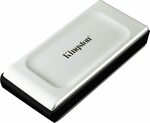One of the smallest, fastest USB SSDs you can get at one of the lowest prices seen at $358 (according to Camel, lowest was $342. Normal price is $400+).
USB 3.2 Gen 2x2 performance:Industry-leading read/write speeds of up to 2,000MB/s
To compare, the Sandisk Extreme Pro (also 2000MBps) is over $100 more ($467).
Ships from Amazon US. Price/shipping for everyone (not a Prime-only deal).
EDIT:
To compare with a Build Your Own:
You need a 2500MBps SSD to get to 20Gbps. So, the cheapest one would be a Crucial P2 2TB for $259 (PLE), plus a Wavelink 20Gbps enclosure for $99 (Amazon) would be $358.
This is much smaller, and much more durable for the same price.



 CamelCamelCamel
CamelCamelCamel

Not interested so i won't check personally but just be wary of sustained write speed. Because i presume to hit 2000mb/s there's a buffer involved.